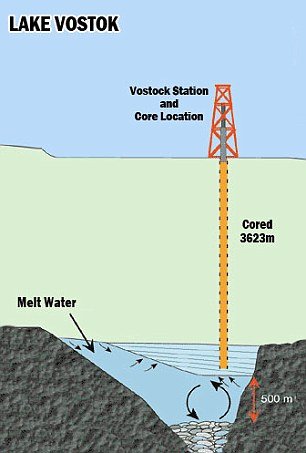
A breakthrough discovery has been made by Russian scientists after they drilled down through four kilometres of Antarctic ice to Lake Vostok that has been sealed for the last 20 million years.
Professor John Priscu, veteran Antarctic researcher, says that he expects to see “unique organisms” in the lake.
But it was revealed this may not be the only surprise from sub-glacial Lake Vostok, a body of water as large as Lake Ontario.
As scientists began the search for new life, a state-run news agency in Russia claimed that an extraordinary cache of Hitler’s archives may be buried in a secret Nazi ice bunker near the spot where yesterday’s breakthrough was made.
“It is thought that towards the end of the Second World War, the Nazis moved to the South Pole and started constructing a base at Lake Vostok,” claimed RIA Novosti, the Russian state news agency.
The news agency cited Admiral Karl Dontiz in 1943 saying: “Germany’s submarine fleet is proud that it created an unassailable fortress for the Fuehrer on the other end of the world, in Antarctica.”
According to German naval archives, months after the Nazis surrendered to the Allies in April 1945, a U-530 submarine arrived at the South Pole from the Port of Kiel.
The crew is rumored to have constructed a still undiscovered ice cave “and supposedly stored several boxes of relics from the Third Reich, including Hitler’s secret files”.
A later claim was that a U-977 submarine delivered remains of Hitler and Eva Braun to Antarctica in the hope they could be cloned from their DNA. The submariners then went to Argentina to surrender, it was claimed.

Microbiologists say that the lake could offer a glimpse of unique life forms. The project has been closely watched by both NASA and the Russian Space Agency.
One hope is that it will give a glimpse of conditions on Jupiter’s moon Europa where water is also believed to exist under a thick ice cover.
“The discovery of microorganisms in Lake Vostok may mean that, perhaps, the first meeting with extraterrestrial life could happen on Europa,” said Dr. Vladimir Kotlyakov, Director of the Geography Institute at the Russian Academy of Sciences.
Specialists at the Russian Arctic and Antarctic Research Institute will now test a sample of water that has been sucked from the lake, and frozen.
Last year, the expedition stopped 10 to 50 metres short of the lake after the weather closed in and the scientists were forced to abandon the expedition.
Academics say they have found “the only giant super-clean water system on the planet”. They forecast the extraordinary 5,400 cubic kilometres of pristine water will be “twice cleaner than double-distilled water”, and any life will have developed in total isolation.
“We’re not talking a new Loch Ness Monster – though we actually cannot really predict what to expect,” an expedition source told Ria Novosti.
“The lake water is a moving body, and despite being almost 4 km under the ice, there is an oxygen supply, and microorganisms have already been found in the ice drilled from close to the roof of Lake Vostok.”
Professor John Priscu told usnews.com in an email that the crews had been working “round the clock” to finish the project before the Antarctic summer ended, which meant no planes could fly from the remote Vostok Station, where temperatures are currently around minus 66C.
“If they were successful, their efforts will transform the way we do science in Antarctica and provide us with an entirely new view of what exists under the vast Antarctic ice sheet,” Prof. John Priscu said.
Geothermal heat under the ice keeps the lake liquid, and its conditions are often described as “alien” because they are thought to be akin to the subterranean lakes on Jupiter’s moon Europa.
“I think we’ll find unique organisms,” Prof. John Priscu, a microbiologist at the University of Montana, and a veteran Antarctic researcher who is on the trip told Scientific American.
On January 13, Prof. John Priscu said the team was progressing well, drilling 5.7 ft a day. He said they had switched from an ice drill to a thermal drill to melt through the last 16 to 32 ft of ice.
“This was the plan, but when you’re in the field, things can change,” Prof. John Priscu, who had been communicating with the group from his office in St. Petersburg, said.
“This has never been done before,” he told OurAmazingPlanet.
“It’s a one-of-a-kind drill, a one-of-a-kind borehole, and a one-of-a-kind lake, so I’m sure they’re making decisions on the fly all the time.”
The team had a deadline of Tuesday, before already ice-cold temperatures in the desolate spot drop another 40 degrees centigrade.
Valery Lukin, chief of the Russian Antactic Expedition, said last month: “We do not know what is waiting for us down there.”
On July 21, 1983, temperatures at Vostok Station hit the lowest level ever recorded on Earth – minus 89.2C.
When the breakthrough moment comes they must take care not to contaminate the hidden underground world with bacteria and fluids from the drilling.
To make sure the water stays completely pure, the machinery will not even touch the lake.
Instead suction will be used to suck samples of the unique water into the borehole, where it will freeze before being raised to the surface for analysis.
The team also faces the risk of an explosion with oxygen and nitrogen trapped below.
They are trying to make sure only a small amount of air can escape to avert the risk.
The scientists have been drilling 24 hours a day in three shifts as they race to break through before winter descends.
Environmental groups have criticized the work on the site – and the chemicals used such as kerosene to keep the hole open.
Others have said the site should not be explored but instead left in pristine condition.